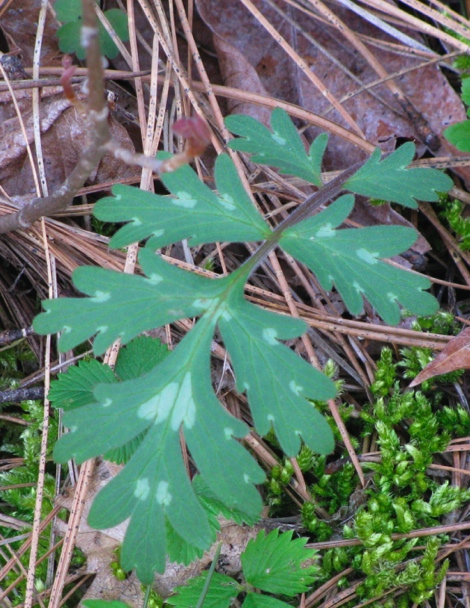In a previous post I showed off one local member of the species Erythronium, E. hendersonii, with pinkish/purplish flowers. This morning up on the middle fork of the Applegate River we found something different, which is probably Erythronium citrinum S Watson, the pale fawn lily.
Another possibility is E. oregonum but Flora of North America says that species is found at altitudes of 0 – 500 m, with E. citrinum at 100 – 1300 m and we found these at 750 m or higher. In addition, the Pacific Bulb Society mentions unusually dark leaves being common on E. citrinum and we saw those. In the end, though, I’m no botanist and won’t wager anything on my identifications of Erythronium species, particularly given what Flora of North America says in the article on citrinum:
Plants lacking auricles on inner tepals are sometimes segregated as Erythronium howellii, Howell’s fawn-lily, but they do not appear to differ from typical E. citrinum in any other characters.
Erythronium citrinum intergrades with E. californicum and E. hendersonii, occasional populations or individuals displaying intermediate or recombined characteristics. [and no, “tepals” is not a typo but a botanical term for one variety of what the rest of us lump together as “petals”]
Anyway, here’s what we saw, beautiful by any name.

The plants are a bit larger and more robust than the pink-flowered E. hendersonii, and the petals are white touched with yellow at the base.

The mottling of the leaves is more pronounced than the leaves of E. hendersonii, and a few plants had nearly chocolate-colored leaves.

Here’s one more close-up; perhaps someone can make an ID from it.

Another species with a white flower touched with yellow is Erythronium montanum, the avalanche lily, but its leaves are plain green, not spotted. The photo below is from Wikipedia. There’s a fantastic close-up of its flowers at the Botany Flower of the Day site.

Rattlesnake plantain, Goodyera oblongifolia, also has distinctively marked leaves, which grow in rosettes flat to the ground. It’s at the left in the picture below, with a damaged erythronium leaf on the right.

The common name “plantain” simply refers to the broad leaves; actually Goodyera oblongifolia is a member of the orchid family, with a spire of small white flowers. I can’t remember ever seeing it in bloom.
Yesterday, in a moist environment above the Applegate River, we found this beauty:

It’s a member of Ribes, the gooseberry or currant family, probably Ribes roezlii, the shiny-leaved gooseberry. Mostly evergreen, with thorns. Wild gooseberries/currants are edible, according to what I read, though some including R. roezlii have berries that are prickly or hairy (photos).
In this wetter area, there were also several of the chocolate lily, Fritillaria affinis, mentioned in a previous post in connexion with the scarlet fritillary seen on an earlier walk.

The flowers weren’t open quite yet but are still striking.

Here’s a plant with a handsome and unusual leaf, as yet unidentified.

Finally, here’s a sweet little wildflower, Viola nuttallii (Nuttall’s violet, Yellow prairie violet). We saw it yesterday in that moister environment overlooking the river.

It’s a food plant for the larva of the Coronis Fritillary butterfly, Speyeria coronis, seen below.

(Photo by Jeffrey Pippen)
We’ve marked down a couple of spots to revisit in a few days, to find out what sort of flowers will appear from some unknown plants. Most of them look lily-ish, just a couple of large linear leaves. What surprises do they hold? even the Shadow doesn’t know, unless he’s keyed out these plants. I’ll wait and be surprised.

Thanks for taking the time to share your discoveries. We recently moved to the upper Applegate and have enjoyed the profusion of unique flora. You helped me identify some plants that appeared this year after removing blackberries along the river so…thank you.
I’m glad to hear that it’s been helpful. This long “spring” has been quite a fine season for wildflowers. Often summer comes more suddenly. Good for you, clearing blackberries.